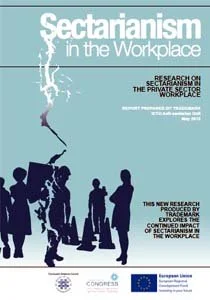Let’s Call Sectarianism What It Really Is
During the recent ‘community relations week’ in the Six Counties (May 12-19), various Stormont ministers, MLAs, members of publicly-funded quangos, media commentators and others, all queued up to address the problem of “sectarianism within society”.
A report published by the Irish Congress of Trade Unions and Trademark during “community relations week” exposed the ongoing impact of sectarianism in the workplace. It found that “sectarianism” remains deeply rooted within the workplace in the Six Counties. The authors described their findings as “worrying” and revealed that 44 per cent of workers in one sector reported they had experienced sectarian harassment.
However, no-one, not even from the trades unions, was brave enough to identify the true nature of sectarianism.
Others outside the Six Counties have been less reticent in acknowledging that sectarianism, by its very essence, is racist.
The 1978 UNESCO Declaration on Race and Racial Prejudice defined any ‘distinction, exclusion, restriction or preference based on race, colour, ethnic or national origin or religious intolerance’ as being ‘incompatible with the requirements of an international order which… guarantees respect for human rights’.
The Council of Europe’s European Commission against Racism and Intolerance (ECRI), whose reports and standards are heavily relied upon in Strasbourg jurisprudence, defines racism as ‘the belief that a ground such as race, colour, language, religion, nationality or national or ethnic origin justifies contempt for a person or a group of persons, or the notion of superiority of a person or a group of persons’.
No less a body than the European Court of Human Rights has further elaborated that, “Having regard to the relevant international instruments…and to its own case-law, the Court would emphasise, in particular, that tolerance and respect for the equal dignity of all human beings constitute the foundations of a democratic, pluralistic society. That being so, as a matter of principle it may be considered necessary in certain democratic societies to sanction or even prevent all forms of expression which spread, incite, promote or justify hatred based on intolerance (including religious intolerance), provided that any ‘formalities’, ‘conditions’, ‘restrictions’ or ‘penalties’ imposed are proportionate.”
More recently, in December 2011, the Advisory Committee on the Framework Convention for the Protection of National Minorities publicly criticised the approach taken by both the Stormont Executive and British government in the Programme for Cohesion, Sharing and Integration (2010).
According to the Advisory Committee, treating sectarianism in the Six Counties as a distinct issue rather than as a form of racism is “problematic” in that it allows sectarianism to fall outside the scope of internationally accepted anti-discrimination and human rights protection standards.
Instead of ‘sectarian attacks’, ‘sectarian discrimination’, ‘sectarian harassment’, ‘sectarian politics’, ‘sectarian parades’ or ‘sectarian divisions’; imagine what the impact would be if a new conversation came about based upon a vocabulary circumscribed by international instruments and human rights-based case-law which define such unacceptable incidents, occurrences and events as racist.
Is that so unthinkable?
In the Six Counties, the harsh reality is that sectarian practices and sectarian politics are deemed to be normal and even legislated for. Organisations which advocate and openly underpin sectarianism are accepted as the norm and even financially rewarded by way of ‘peace and reconciliation’ and other funding.
Until sectarianism is acknowledged and recognised for what it really is – a form of racism – perhaps the simple garden spade should be designated as “an individually-operated manual earth-moving and/or excavation implement”.
Ultimately, the latter description only merely deflects attention away from reality.

